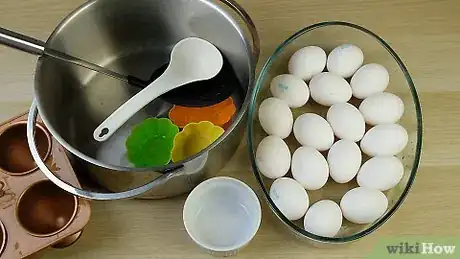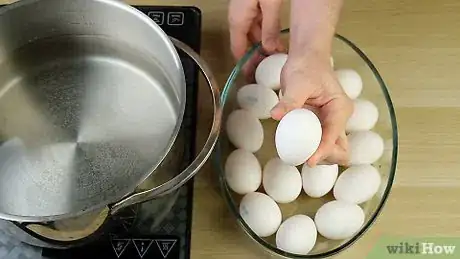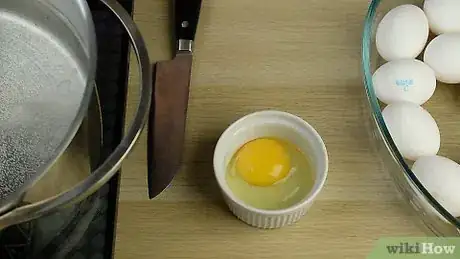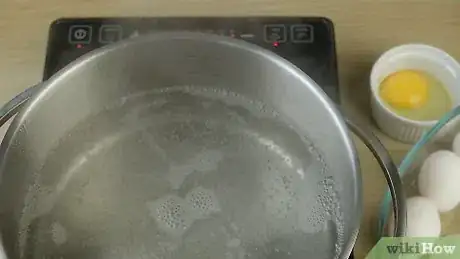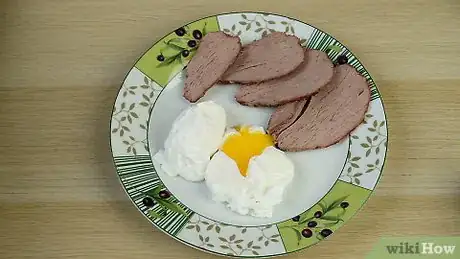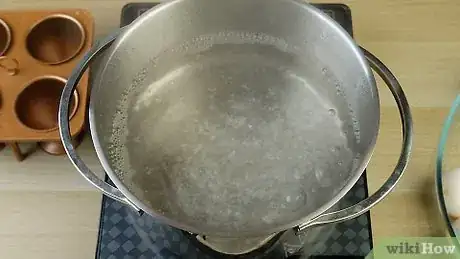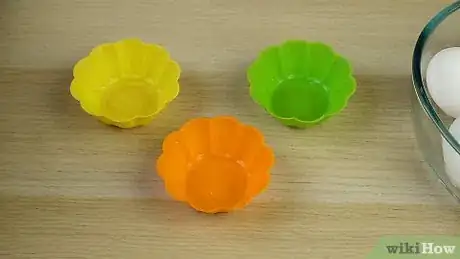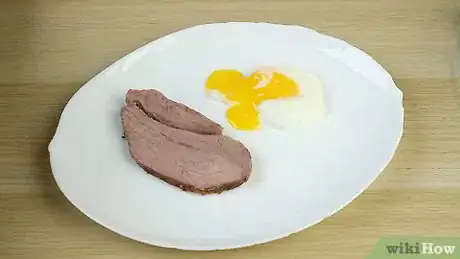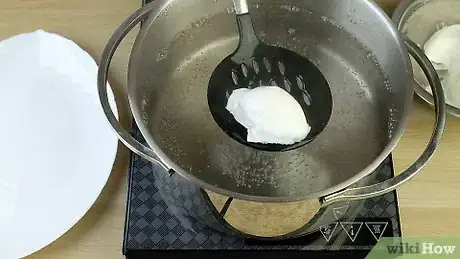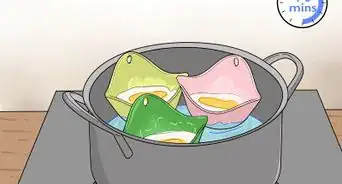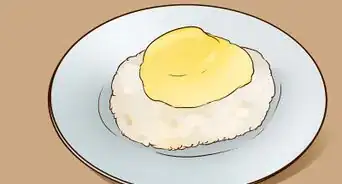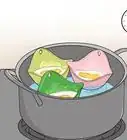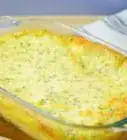This article was co-authored by wikiHow Staff. Our trained team of editors and researchers validate articles for accuracy and comprehensiveness. wikiHow's Content Management Team carefully monitors the work from our editorial staff to ensure that each article is backed by trusted research and meets our high quality standards.
The wikiHow Culinary Team also followed the article's instructions and verified that they work.
This article has been viewed 3,838,778 times.
Learn more...
Poaching eggs is a healthy way to prepare eggs, since you don't need butter or oil to cook with. Poached eggs can be eaten as they are, on salads or bread or made into eggs Benedict. The perfect poached egg will have a smooth, unbroken yolk surrounded by a shiny opaque oval of egg white that sits evenly around the egg. While you may feel a little intimidated at the thought of creating such perfection, it's actually very straightforward, even without the use of a poacher. Follow these instructions to produce a poached egg able to impress any breakfast or brunch guest you're serving!
Ingredients
- Eggs (as many as you wish to serve)
- Water
- White vinegar (optional)
Using a Pan to Poach Eggs
-
1Select a suitable pan for poaching. The pan must be shallow and wide, as the trick to poaching well, without an egg poacher is to gently slip the egg into a wide, shallow pan filled with simmering water. The pan should be able to take about 1.5 liters (0.4 US gal) (2 3/4 pints) of water, or 10cm (4") depth of water.
-
2Add the water. Fill the pan about two-thirds or a bit more with water and bring to a gentle boil.
- Milk can be used in place of water if you're seeking a richer taste.
-
3If you'd like to help the eggs to set, add 5-10ml (1-2 teaspoons) of white vinegar to the water. It's not essential but it improves the egg's appearance because the vinegar coagulates the egg white.[1]
- Other vinegars (balsamic, red wine vinegar, apple cider vinegar) are fine, and sometimes taste great when poaching eggs, but will possibly affect the final coloration.
- Larousse Gastronomique recommends 1 tablespoon of vinegar to be added per 1 liter (0.26 US gal) (1 3/4 pints, 4 1/3 cups) of water. On the other hand, chef Michael Romano recommends adding one teaspoon of vinegar per liter (1 3/4 pints).[2]
- Lemon juice can also help set the egg, but its flavor will also come through. Some people advise to add salt, but it can hinder coagulation, so it's best not used.
- If vinegar is used, the eggs will have a vinegary taste. Chef Michael Romano advises that in commercial restaurants, poached eggs are usually plunged into another pan of hot water which is salted but vinegar free and that this both seasons them and removes the vinegary taste.[2]
-
4Select the eggs. The fresher an egg is, the better it will poach because its white is thicker. Use eggs that are as fresh as possible; an egg straight from the chicken will poach without any need for vinegar as it will coagulate immediately.[3]
-
5Poach at an easy pace. For the best results, only poach one egg at a time. More than one egg risks merging into other eggs when cooking. If you need to poach more than one at once, stop at four because any more will throw out the timing and merging mess is inevitable. The instructions following deal with both a single egg and up to four eggs at a time.
-
6Crack an egg into a ramekin, small bowl or soup ladle. Do this gently so as not to harm the appearance of the egg. Alternatively, crack the egg onto a small, flat plate as this makes sliding the egg into the pan of water easier. Don't break the yolk when cracking the egg.
- Given the possibility of breaking the egg when moving it from a bowl or plate to the pan, some people prefer to skip this step and break the egg straight into the water. If you do this, be careful and only add one at a time. And note that by cracking the eggs separately into a cup and not straight into the water, the cracked eggs have the chance to set back up into their little "protein cocoon". You might like to experiment to work out what works best for you.
-
7Turn down the gently boiling water to a simmer. The water should be barely simmering and the temperature about 160-180ºF (71-82ºC).[4]
- Make sure that you do not drop the egg into boiling water (100ºC/212ºF), as this will toughen the eggs and make them unpalatable.
-
8Spin the simmering water to cool down the water before you drop in the single egg.
-
9Carefully lower or drop the egg into the center of the barely simmering whirlpool. To help maintain the shape of the egg, swirl around it in a circular motion.
- Chef Michael Romano recommends using a basting method to envelop the yolk with the white, shaping it like this for about 20 seconds or until the white sets.[2]
-
10Wait 3-5 minutes until cooked. You will know that the egg is cooked when the whites are set and the yolks begin to thicken.
-
11If poaching multiple eggs at once, do not spin the boiling water. Place the first bowl with its side just breaking the surface of the water. With a gentle quick motion, dump the egg into the water.[5]
- Quickly repeat this step with the other eggs, adding them at 10-15 second intervals. Leave plenty of space for the eggs in the saucepan. Depending on the size of the pan, two or three eggs at a time is about right.
- Remove each egg in succession after they have cooked for three minutes each.
-
12Remove the poached egg with a slotted spoon. Work quickly to transfer each egg onto the plate, letting excess water drip back into the pan. Larousse Gastronomique advises to refresh the egg in cold water and then drain on a cloth. Chef Michael Romano recommends dipping the eggs into simmering, salted water for 30 seconds and placing them on a dry tea towel to dry.
- If the edge isn't neat enough, trim with kitchen shears––the cook's secret.
-
13Serve. Poached eggs should be served as soon as they're removed from the water and drained. They cool down quickly and once cold, they're not as desirable for the diner.
- Serve on thick slices of crusty toast.
- Serve with baked beans, a cooked tomato and sausages.
- Serve with a salad.
- Serve inside a pita bread pocket.
- Serve on vegetables.
- Serve the poached eggs over toasted buttered English muffins and topped with Bearnaise or Hollandaise sauce, maybe a little bacon or grilled ham on the side.
- Serve as eggs Benedict.
Using an Individual Egg Poacher
-
1Use the steps outlined in the previous method. However, when it comes to adding the egg, add the egg poacher first. It should have a hook that sits on the edge of the pan; simply hook this into place prior to sliding in the egg.
-
2Add the egg straight into the egg poacher.
-
3Cook as outlined above, then pull out the whole egg poacher. Drain and serve as outlined above.
Using a Silicon Egg Poacher Cup
-
1If you have access to a good kitchen store, consider purchasing a small silicon egg poacher cup or a set of silicon egg poachers (a set often comes with a pan with a clear lid). This is a fairly inexpensive option and they're very easy to use.
-
2Float the cup in the pan.
-
3Bring to simmer and break the eggs into the cups.
-
4Simmer with a covered pan for 8 minutes (at sea level).
-
5Use a butter knife to separate the poached egg at edge of cup and invert the cup over toast.
-
6Serve.
Making Poached Eggs in Advance
-
1In spite of what was said about serving immediately, as noted by Julia Child and other chefs like Michael Romano, it is possible to make poached eggs in advance for the busy cook with a crowd to feed.
-
2Make the poached eggs as outlined above.
-
3Simply plunge the poached eggs into plain icy water to chill. Place in the refrigerator and leave until it's time to serve - they keep well for up to a day in the refrigerator.[6]
-
4Drop them into a pan of simmering, salted water for 20-30 seconds (and no more than one minute) and they're ready to serve immediately. Do not cook them any further than this. Use the serving suggestions above.
If the Yolk Breaks in the Water
-
1If the yolk breaks in the water, do not panic. Simply use a slotted spoon and gently mix the water from the edges of the pan to obtain a round shape. Serve as informed above.
-
2If the careful mixing doesn't work and the shape is not respectable, scoop out the egg (when cooked) with a slotted spoon. Serve onto a piece of crisp garlic bread or French bread. Add seasoning and vegetables to the egg and any sauce of your choice (preferably Hollandaise, mayonnaise or Thousand Islands). This will cover up the broken yolk.
- Leftovers such as pasta, kebabs, lobster, ox tongue, meringue, rolls and soup can be used as side dishes to divert the guest's attention.
- Note: This save method is preferable for one egg. More eggs could be hidden between toast or inside another dish.
Community Q&A
-
QuestionHow do I get that perfect mounded shape with a poached egg?
 wikiHow Staff EditorThis answer was written by one of our trained team of researchers who validated it for accuracy and comprehensiveness.
wikiHow Staff EditorThis answer was written by one of our trained team of researchers who validated it for accuracy and comprehensiveness.
Staff Answer wikiHow Staff EditorStaff AnswerThe fresher the egg, the neater the poached egg will appear. Older eggs tend to fall apart in the poaching water. If you want that lovely mounded shape that stays neat, then use fresh eggs. If you're unsure how fresh your eggs are, check out the wikiHow: How to Tell if Your Eggs Are Fresh.
wikiHow Staff EditorStaff AnswerThe fresher the egg, the neater the poached egg will appear. Older eggs tend to fall apart in the poaching water. If you want that lovely mounded shape that stays neat, then use fresh eggs. If you're unsure how fresh your eggs are, check out the wikiHow: How to Tell if Your Eggs Are Fresh. -
QuestionHow long do I need to cook the egg for so it's properly poached?
 wikiHow Staff EditorThis answer was written by one of our trained team of researchers who validated it for accuracy and comprehensiveness.
wikiHow Staff EditorThis answer was written by one of our trained team of researchers who validated it for accuracy and comprehensiveness.
Staff Answer wikiHow Staff EditorStaff AnswerThe article suggests 8 minutes is a good time. However, you may prefer the yolk to be runny, and if so, cook for 4–5 minutes and as long as the egg white is set, the poached egg will be ready.
wikiHow Staff EditorStaff AnswerThe article suggests 8 minutes is a good time. However, you may prefer the yolk to be runny, and if so, cook for 4–5 minutes and as long as the egg white is set, the poached egg will be ready. -
QuestionCan I refrigerate poached eggs?
 wikiHow Staff EditorThis answer was written by one of our trained team of researchers who validated it for accuracy and comprehensiveness.
wikiHow Staff EditorThis answer was written by one of our trained team of researchers who validated it for accuracy and comprehensiveness.
Staff Answer wikiHow Staff EditorStaff AnswerYes, poached eggs can be refrigerated. Place the eggs into a bowl of icy cool water and cover the bowl with a lid or wrap. Then carefully place the bowl into the refrigerator. They can be kept there for up to 1 day (24 hours). To prepare for eating, heat the water and drop in for a minute, then remove and serve.
wikiHow Staff EditorStaff AnswerYes, poached eggs can be refrigerated. Place the eggs into a bowl of icy cool water and cover the bowl with a lid or wrap. Then carefully place the bowl into the refrigerator. They can be kept there for up to 1 day (24 hours). To prepare for eating, heat the water and drop in for a minute, then remove and serve.
Warnings
- Do not drop the egg into boiling water (100ºC/212ºF)! This will negatively affect the taste and texture of your eggs because a rolling boil might just rip the egg apart. As a rule of thumb, bring the water to a boil, then reduce it to a simmer (or very gentle boil) before cooking.⧼thumbs_response⧽
- If the yolk breaks as you crack the egg or as you are putting the egg in the water, that egg is a goner. Pull it out and use it for something else if you can; perhaps someone wants scrambled eggs instead.⧼thumbs_response⧽
- Only store cooked eggs if they have cooked right through.⧼thumbs_response⧽
References
- ↑ https://whatscookingamerica.net/Eggs/PoachEgg.htm
- ↑ 2.02.12.2DK, The Cook's Book, p. 131, (2005), ISBN 1-74033-454-X
- ↑ https://whatscookingamerica.net/Eggs/PoachEgg.htm
- ↑ https://whatscookingamerica.net/Eggs/PoachEgg.htm
- ↑ https://whatscookingamerica.net/Eggs/PoachEgg.htm
- ↑ https://www.bbc.com/food/techniques/how_to_poach_eggs_in_advance
- John Newton, Food: The Essential A-Z Guide, p. 132, (2001), ISBN 1-74045-031-0 – research source
- Good Housekeeping, Complete Cookbook, p. 28, (2000), ISBN 0-00-710074-4 – research source
- Larousse Gastronomique, Poached eggs, p. 402, (2009), ISBN 978-0-600-62042-6 – research source
- DK, The Cook's Book, p. 131, (2005), ISBN 1-74033-454-X – research source
About This Article
To poach an egg, first crack an egg into a small bowl. Make sure the eggs you’re using are as fresh as possible. Then, fill a pot with enough water to cover the egg completely and add a splash of vinegar, which will help the egg keep its shape while it’s cooking. Bring the water to a simmer and carefully pour the egg into the water. Let it cook for 3 to 4 minutes or until the egg white is completely set. Finally, use a slotted spoon to transfer the egg to a plate, and enjoy! If you’re poaching more than one egg at a time, pour each egg into the same pot of simmering water. Cook them for 2 minutes, then turn off the heat and let them cook for a few more minutes until the egg whites are set. Once the egg whites are set, transfer the eggs to a plate with a slotted spoon and enjoy! For tips from the wikiHow test kitchen on how to deal with accidents, like if the yolk breaks, keep reading!
